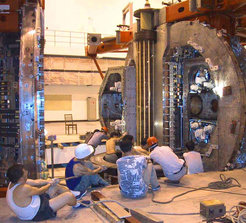ASDEX – German fusion device now re-operating in China
First Plasma on 2 December / ceremony in Chengdu / far-reaching plans
The ASDEX (Axially Symmetric Divertor Experiment) large-scale device was shut down in 1990 after ten years of successful experimentation, when its successor, ASDEX Upgrade, went into operation at Garching. The internationally acclaimed results achieved with ASDEX including the discovery of a plasma state with improved thermal insulation made it one of the most successful fusion devices of the eighties.

After shutdown the People’s Republic of China expressed interest in the device. In 1995, ASDEX – after approval from the German and European funding authorities – was dismantled by a team of Chinese engineers and technicians at Garching. The dismantled components, individually numbered and named, were packed in over 1,000 chests for small items and several containers for large elements and shipped to China in 1996. Dismantling of the experiment, documentation, shipping of the 350-ton device and its re-assembly were solely handled by SWIP, who also met all of the costs. The ASDEX team provided technical know-how and the necessary plans and gave advice on dismantling and re-assembly at Chengdu as of 1999. The heating and measuring facilities for the plasma as well as the control and power supply systems were built new in China. With these additions and under its new name, HL-2A (A for ASDEX), the device resumed operation on 2 December 2002 as China’s biggest fusion experiment at present.
This will change when, in about three years, the HT-7U fusion experiment goes into operation at Hefei, where it is being built in the Institute of Plasma Physics of the Chinese Academy of Sciences. Whereas HL-2A at Chengdu will be primarily concerned with basic research, China’s aim with HT-7U is to tackle topical questions of fusion research. Unlike the Chengdu device with normally conducting copper coils, HT-7U is to confine the plasma in magnetic fields generated by superconducting coils and achieve long discharge pulses lasting several minutes. This will enable the experiment to deal with one of the most topical subjects at present: By means of new technologies it is to pave the way to continuous operation of fusion devices of the tokamak type, which today are still operated in pulsed mode.
Furthermore, China recently voiced interest in participating in the large, international ITER project. The ITER test reactor – the next step in international fusion research – is now being jointly prepared by European, Japanese and Russian scientists. ITER is to demonstrate that energy production by fusion is physically and technically possible, and produce a burning fusion plasma for the first time.
Background
ASDEX in its time was one of the most successful fusion experiments: The aim of fusion research is to develop a power plant that provides energy from fusion of atomic nuclei. The fuel is an ionised low-density gas, a hydrogen plasma, that has to be confined in magnetic fields and heated to very high temperatures in order to light the fusion fire. One objective of ASDEX (Axially Symmetric Divertor Experiment) was to test a special magnetic field configuration – called divertor – which would ensure clean plasmas. The divertor concept has proved extremely effective in keeping the plasma clean. Then there was an unexpected second favourable effect, viz. a distinct enhancement of the thermal insulation of the plasma in the so-called high-confinement regime. Without this improvement it would not be possible to produce a burning plasma in a future power plant.
The ASDEX results were so significant that the concept developed at Garching was adopted all over the world. A future fusion power plant will also work with a divertor. Since 1991 IPP at Garching has been operating ASDEX Upgrade as successor. It is testing the divertor under power-plant-like conditions. ASDEX Upgrade is therefore particularly suitable for preparing the ITER international test reactor. With this next great step, international fusion research aims to produce the world’s first burning and energy-producing fusion plasma.
Isabella Milch
